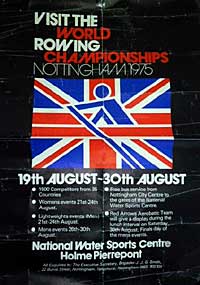
Rowing

With the River Trent running through Nottingham and Newark, rowing became a pastime during the mid-1800s. Attempts to popularize the sport through regattas met with considerable support. The boats of course were not as light as those now in use and sliding seats had not been invented. The clubs were often supported by men of some standing with in the county and prominent rowing men. The first club to open was the Nottingham Rowing Club in 1862 and became the most established of all the Nottingham rowing clubs. Sir John Turney of Turney Leatherworks at Trent Bridge was a founder member of the club and became President in 1890. The Nottingham Britannia Rowing Club was to follow and opened in 1869 and was an offspring of a canoe club and it was not until 1892 that the club had its own boat yard. The Nottingham Union Rowing Club was the next club to be opened in 1871 and most of the rowing was done from the City side of the river. The club gained status as a rowing club and with increased membership, new accommodation to be found on the opposite bank in 1899. The club did very well and in 1914 the first Nottingham club to compete at the Royal Henley Regatta. A coxless four reached the semi-finals of the Wyfold Cup. In 1928 the coxed four which had taken part in the Henley Regatta was chosen to represent Great Britain at the Olympic Games in Amsterdam. The Nottingham Boat Club began in 1894 and had Lord Henry Bentinck as President and in 1897 the boathouse was built on the Trent. Nottingham Rowing club and Nottingham Union club amalgamated in February 1946 to become the Nottingham and Union Rowing club. Although in the early days rowing was essentially a male sport, the clubs did much to foster a love of aquatics among ladies and in 1908 a Ladies’ boat club was formed. This no longer exists and all the boat clubs are mixed.
The clubs have produced some outstanding oarsmen through the Notts County Rowing association scheme, including Carl Smith, a former World Rowing champion who won four golds at world level including the 1986 championship which was held at the National Water Sports Centre, Holme Pierrepont. He was killed in a motoring accident some years ago. Steve Trapmore came to Nottingham in 1995 to study and in 1996 joined the NCRA and was a member of the 2000 Sydney Olympics men’s eight who beat the Australians to take gold.
Newark is the only other town in the county where rowing has flourished. Originally there were two clubs, the Newark Rowing club established in 1873 and the Newark Magnus club associated with Magnus School in Newark. The first races were rowed from Farndon ferry to Averham weir and in 1875 the club held its first Annual Regatta but because of an increase in entries it was decided to restrict the regatta to club members only in 1880. With the opening of a new boat house in 1881 it was felt that the event could be opened up to other clubs. The 1885 fixture was a success with such attractions such as water tournaments and an open swimming race. Once again the club had long line of notable Presidents including G. Tallent.
The National water Sports Centre at Holme Pierrepont was built in 1972 with the intention of attracting sports like rowing to the Midlands and away from London. Initially there was a burst of enthusiasm and in 1975 the World Rowing Championships were held at the Centre, this was repeated again in 1986. However, the main rowing activity at the Centre is training for the local clubs and Annual regattas during the season, again for local clubs.